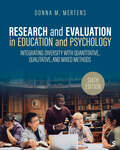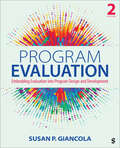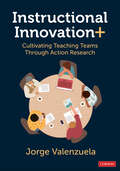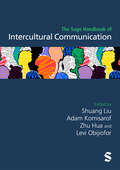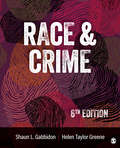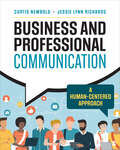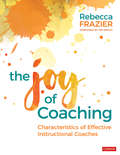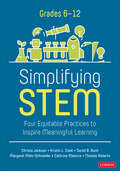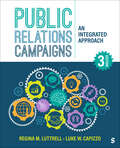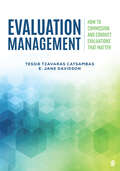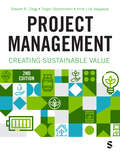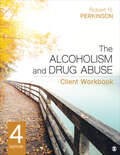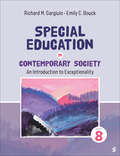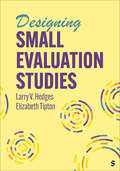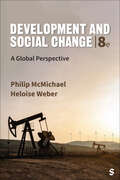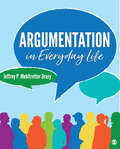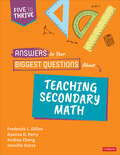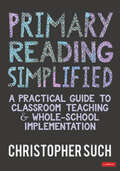- Table View
- List View
Research and Evaluation in Education and Psychology: Integrating Diversity With Quantitative, Qualitative, and Mixed Methods
by Donna M. MertensIdentify, evaluate, and practice good research using Research and Evaluation in Education and Psychology: Integrating Diversity With Quantitative, Qualitative, and Mixed Methods by renowned scholar Donna M. Mertens. This introductory research methods text incorporates the viewpoints of various research paradigms into its descriptions of qualitative, quantitative, and mixed methods as well as program evaluation. The work covers five major paradigms: post-positivist, constructivist, transformative, pragmatic, and Indigenous. Special emphasis on conducting research with culturally complex communities, based on the perspectives of feminists, ethnic/racial minorities, and people with disabilities is a hallmark of this text. In each chapter, the author carefully explains each step of the research process, from the literature review to analysis and reporting. Additionally, each chapter includes a published sample study and abstract to illustrate the concepts discussed in that chapter. The Sixth Edition includes more on community engagement, recent advances in mixed methods, new applications of theoretical frameworks, and the latest research examples. Citations and references have all been updated to reflect the seventh edition of the Publication Manual of the American Psychological Association. Included with this title: LMS Cartridge: Import this title’s instructor resources into your school’s learning management system (LMS) and save time. Don’t use an LMS? You can still access all of the same online resources for this title via the password-protected Instructor Resource Site.
Mathematize It! [Grades K-2]: Going Beyond Key Words to Make Sense of Word Problems, Grades K-2 (Corwin Mathematics Series)
by Linda M. Gojak Sara Delano Moore Kimberly Morrow-Leong"This book is a must-have for anyone who has faced the challenge of teaching problem solving. The ideas to be learned are supported with a noticeably rich collection of classroom-ready problems, examples of student thinking, and videos. Problem solving is at the center of learning and doing mathematics. And so, Mathematize It! should be at the center of every teacher’s collection of instructional resources." John SanGiovanni Coordinator, Elementary Mathematics Howard County Public School System, Ellicott City, MD Help students reveal the math behind the words "I don’t get what I’m supposed to do!" This is a common refrain from students when asked to solve word problems. Solving problems is about more than computation. Students must understand the mathematics of a situation to know what computation will lead to an appropriate solution. Many students often pluck numbers from the problem and plug them into an equation using the first operation they can think of (or the last one they practiced). Students also tend to choose an operation by solely relying on key words that they believe will help them arrive at an answer, which without careful consideration of what the problem is actually asking of them. Mathematize It! Going Beyond Key Words to Make Sense of Word Problems, Grades K-2 shares a reasoning approach that helps students dig into the problem to uncover the underlying mathematics, deeply consider the problem’s context, and employ strong operation sense to solve it. Through the process of mathematizing, the authors provide an explanation of a consistent method—and specific instructional strategies—to take the initial focus off specific numbers and computations and put it on the actions and relationships expressed in the problem. Sure to enhance teachers’ own operation sense, this user-friendly resource for Grades K-2 · Offers a systematic mathematizing process for students to use when solving word problems · Gives practice opportunities and dozens of problems to leverage in the classroom · Provides specific examples of questions and explorations for addition and subtraction of whole numbers as well as early thinking for multiplication and division · Demonstrates the use of concrete manipulatives to model problems with dozens of short videos · Includes end-of-chapter activities and reflection questions How can you help your students understand what is happening mathematically when solving word problems? Mathematize it!
Introduction to Business
by Heidi M. Neck Emma L. Murray Christopher P. NeckIntroduction to Business ignites student engagement and prepares students for their professional journeys, regardless of their career aspirations. Best-selling authors Heidi M. Neck, Christopher P. Neck, and Emma L. Murray inspire students to see themselves in the world of business and to develop the mindset and skillset they need to succeed. A diverse set of impactful examples and cases, from inspiring startups and small businesses to powerful corporations, illustrate how businesses can prosper and create positive impact.
Program Evaluation: Embedding Evaluation into Program Design and Development
by Susan P. GiancolaThis text aims to build evaluation capacity by increasing knowledge about evaluation and improving skills to conduct evaluations. The book’s embedded approach uses program theory to understand relationships between activities and objectives, logic modeling to represent the program’s theory, and an evaluation matrix to structure the evaluation within the program. The approach is systematic and focused on continuous improvement. The Second Edition adds topics suggested by users of the book, incorporates content that the author has added to her own classes, and covers emerging areas in evaluation since the publication of the first edition such as artificial intelligence and equity in evaluation. A companion website at http://edge.sagepub.com/Giancola2e includes a number of instructor resources including editable PowerPoint slides and assignments.
A Student′s Guide to Therapeutic Counselling
by Traci Postings Heather Price Kelly BuddThis highly practical book, published in partnership with CPCAB, is a comprehensive training guide for learners on diploma practitioner courses at Level 4 and above. Based around CPCAB’s seven core processes of practitioner development, it introduces core curriculum topics including knowledge, skills and practice issues. It provides learners with essential support through study tips and answers to their most commonly asked questions.
The Sage Encyclopedia of LGBTQ+ Studies, 2nd Edition
by Abbie E. GoldbergThe SAGE Encyclopedia of LGBTQ Studies, 2nd Edition is aimed at students and educators interested in an interdisciplinary perspective on LGBTQ issues. It examines and provides understandings of the lives and experiences of LGBTQ individuals, with attention to the contexts and forces that shape their world. The volume addresses questions such as: What are the key theories used to understand variations in sexual orientation and gender identity? What does LGBTQ+ affirmative therapy look like? How have anti-LGBTQ ballot measures affected LGBTQ people? What are LGBTQ+ people’s experiences during COVID-19? How were LGBTQ+ people impacted by the Trump administration? What is life like for LGBTQ+ people living outside the United States? This encyclopedia looks at LGBTQ issues and identity primarily through the lenses of psychology, human development, and sociology, while emphasizing queer, feminist, and ecological perspectives on this topic. Entries are written by top researchers and clinicians across multiple fields—psychology, human development, gender/queer studies, sexuality studies, social work, nursing, cultural studies, education, family studies, medicine, public health, and sociology.
Instructional Innovation+: Cultivating Teaching Teams Through Action Research
by Jorge ValenzuelaEmpower teaching teams with data-driven instructional innovation With teacher shortages, high staff turnover, and an influx of new and underprepared teachers, highly capable data-informed teaching teams are needed now more than ever. Instructional Innovation+ provides educators with a systematic action research approach to achieve instructional innovation and guide teaching teams to success through careful analysis, collaboration, and implementation. Inside you’ll discover A new model, flexible framework and tools for teaching teams to develop their own unique system for effective collaboration and feedback How to develop and implement instructional methodologies and strategies to enhance student learning How to gather and analyze data to inform innovative teaching strategies How to identify your students’ unique needs, plus guidance for initiating improvements in the classroom This impactful guide helps your teaching teams bridge the ever-widening gap between proven strategies and student success through practical and sustainable instructional innovation.
The Sage Handbook of Intercultural Communication
by Shuang Liu Levi Obijiofor Zhu Hua Adam KomisarofThe SAGE Handbook of Intercultural Communication offers a global, interdisciplinary, and contextual approach to understanding the complexities of intercultural communication in our diverse and interconnected world. The handbook brings together established theories, methodologies, and practices and provides a comprehensive exploration of intercultural communication in response to the challenges and opportunities presented by our global society. Featuring contributions from leading and emerging scholars across multiple disciplines, including communication studies, psychology, applied linguistics, sociology, education, and business, this handbook covers research spanning geographical locations across Europe, Africa, Oceania, North America, South America, and the Asia Pacific. It focuses on specific contexts such as the workplace, education, family, media, crisis, and intergroup interactions. Each chapter takes a contextual approach to examine theories and applications, providing insights into the dynamic interplay between culture, communication, and society. From managing cultural diversity in the workplace to creating culturally inclusive learning environments in educational settings, from navigating intercultural relationships within families to understanding the role of media in shaping cultural perceptions, this handbook delves into diverse topics with depth and breadth. It addresses contemporary issues such as hate speech, environmental communication, and communication strategies in times of crisis. It also offers theoretical insights and practical recommendations for researchers, practitioners, policymakers, educators, and students. The handbook is structured into seven parts, beginning with the theoretical and methodological development of the field before delving into specific contexts of intercultural communication. Each part provides a rich exploration of key themes, supported by cutting-edge research and innovative approaches. With its state-of-the-art content and forward-looking perspectives, this SAGE Handbook of Intercultural Communication serves as an indispensable resource for understanding and navigating the complexities of intercultural communication in our increasingly interconnected world. Part 1: Theoretical and methodological development of the field Part 2: Intercultural communication in workplace contexts Part 3: Intercultural communication in educational contexts Part 4: Intercultural communication in family contexts Part 5: Intercultural Communication in media contexts Part 6: Intercultural communication in crisis contexts Part 7: Intercultural communication in intergroup contexts
Race and Crime
by Shaun L. Gabbidon Helen Taylor-GreeneWritten by two of the most prominent criminologists in the field, Race and Crime, 6th Edition takes an incisive look at the intersection of race and ethnicity and the criminal justice system. A thought-provoking discussion of contemporary issues uniquely balances the historical context and modern data and research to offer students a panoramic perspective on race and crime. Accessible and reader friendly, this comprehensive text shows students how race and ethnicity have mattered and continue to matter in all aspects of the administration of justice.
Business and Professional Communication: A Human-Centered Approach
by Curtis Newbold Jessie Lynn RichardsBusiness and Professional Communication: A Human-Centered Approach prepares students to succeed in today’s workplace defined by changing technology, a diversifying workforce, and an increase in remote and hybrid work. Authors Curtis Newbold and Jessie Lynn Richards guide students through the principles, practices, and techniques, helping them see that business communication is more than just a series of documents, meetings, and presentations – it’s a human-centered process that requires a holistic understanding of communication across modes and contexts. With accessibility and inclusion leading the way, this text encourages students to be more conscientious, purposeful, and ethical in the way they communicate at work and beyond.
The Joy of Coaching: Characteristics of Effective Instructional Coaches
by Rebecca A. FrazierThe secrets of coaching excellence are already inside you Successful coaching has long been seen as a mental exercise—in order to do right by the teachers you serve, you put theory into practice, establish orderly processes, analyze data effectively, and implement externally mandated reforms. The truth, though, is that truly great coaches derive their success not just from what they do, but also from who they are. This groundbreaking book, based on research from an innovative mixed-methods study, provides a holistic approach to coaching that honors both mind and heart. As you explore the most important characteristics of the best instructional coaches—caring, authenticity, trustworthiness, flexibility, and more—you’ll develop and hone those same characteristics in yourself. Features include: · A framework and structure for developing the characteristics of effective instructional coaches · Comprehensive analysis of each characteristic · Examples and stories of effective coaching in action · Activities, exercises, and action points · Resources for encouragement and renewal School coaches have the power to make a real difference in the lives and futures of teachers and students. By balancing your outward competencies with the inspirational application of your own inward growth, you’ll bring new joy—and success—into your coaching relationships.
Simplifying STEM [6-12]: Four Equitable Practices to Inspire Meaningful Learning (Corwin Mathematics Series)
by Sarah B. Bush Kristin L. Cook Margaret J. Mohr-Schroeder Christa Jackson Oliver Roberts Cathrine MaiorcaStart, focus, or extend your integrated STEM education journey with an authentic interdisciplinary perspective! In response to calls for active STEM learning that builds students’ agency and sense of belonging, teachers and leaders are being encouraged more and more to equitably implement integrated STEM instruction. This practical guidebook is designed to help educators create integrated STEM learning experiences that are inclusive for all students and allows them to experience STEM as scientists, innovators, mathematicians, creators, engineers, and technology experts! Addressing the STEM status quo and promoting inclusiveness in STEM fields, the authors center their work around the Equity-Oriented Conceptual Framework for STEM Literacy, which provides high-quality integrated strategies to connect students′ lived experiences to STEM learning. Simplifying STEM provides a ground-breaking model of the four Integrated STEM Practices (ISPs) to ensure coherent and aligned teaching across disciplines through authentic opportunities to meaningfully engage students. Learn how to simplify STEM with these four equitable practices to inspire deep learning Use critical and creative thinking to seek solutions Collaborate and use appropriate tools to engage in iterative design Communicate solutions based on evidence and data Recognize and use structures in real-world systems Including a STEM planning guide as well as instructional strategies and assessments for standard alignment, this is an essential resource for any educator seeking to empower their students with meaningful STEM learning experiences. The book includes an online implementation toolkit to give educators opportunities for powerful professional development built on collaboration and connection.
Public Relations Campaigns: An Integrated Approach
by Regina M. Luttrell Luke W. CapizzoPublic Relations Campaigns: An Integrated Approach introduces students to the process of creating public relations campaigns using a hands-on approach that emphasizes the tools students will need when working in the industry. Authors Regina M. Luttrell and Luke W. Capizzo present real examples and current case studies to help students develop practical skills for creating more effective PR campaigns. Students are given multiple opportunities to practice and build their skills throughout the book by learning how to apply the PESO model—Paid media, Earned media, Social media, and Owned media—to concept cases. The Third Edition emphasizes the importance of diversity initiatives and further highlights an integrated approach that encompasses aspects of social media, marketing, advertising, and client management for a broader view of the campaign planning process.
RIGOR Unveiled: A Video-Enhanced Flipbook to Promote Teacher Expertise in Relationship Building, Instruction, Goals, Organization, and Relevance
by James Marshall Douglas Fisher Nancy FreyA professional development assessment tool to elevate learning and instruction in every classroom This unique, hands-on flipbook is designed as a classroom observation tool that redefines RIGOR, with a focus on five key elements, or indicators, that form a framework to promote a rigorous, scaffolded learning environment. Explore the five indicators on a RIGOR Walk to identify teacher strengths and areas for growth, and to set goals: Relationships Instruction Goals Organization Relevance Developed for teachers, teams, instructional coaches, and school leaders, RIGOR Unveiled provides a wealth of support and knowledge for classroom observation and reflection, including: Tabbed sections that describe each of the five indicators to help focus discussion and evaluations Rubrics for evaluation including ratings, evidence, and "My Next Steps" 100+ video spotlights defining key concepts 25 classroom videos showing each of the indicators in action 25 videos of coaches discussing what they observed in each of the classroom videos Sturdy flipbook format for individual and team use and easy writing on the go Spot It Happening feature to calibrate observations as they happen Together your teaching teams can improve the learning outcomes for students by committing to continuous improvement in their teaching practice. With this book in hand, you’ll have everything you need to make it happen.
Evaluation Management: How to Commission and Conduct Evaluations that Matter
by Anastasia (Tessie) Catsambas E. Jane DavidsonEvaluation Management: How to Commission and Conduct Evaluations that Matter helps evaluation teams and commissioners achieve results that meet utilization and organizational learning goals and inform positive change for programs and communities. Tessie Tzavaras Catsambas and E. Jane Davidson provide insights on both the tactical and strategic levels of evaluation management, using approaches and skills from project management, administration and logistics, budgeting, team management, leadership development, communication, coaching, systems thinking, and negotiation. They also demonstrate how intentionality for equity, sustainability and culturally responsive practices is essential for ensuring an evaluation’s relevance and enhancing productive stakeholder engagement. With plenty of practical guidance from many years of experience, the authors provide a valuable resource for student readers, experienced evaluators, and commissioners of evaluation.
Project Management: Creating Sustainable Value
by Stewart R Clegg Torgeir Skyttermoen Anne Live VaagaasarThe second edition of this comprehensive textbook has been fully revised and updated, streamlining chapters and ensuring accessibility. Sustainability is now at the core of this textbook, showing students how projects can achieve success and create value for all stakeholders, ensuring projects for people, planet and prosperity. Key features of this edition include: • Sustainability Development Goal icons throughout highlighting where topics related to sustainability are covered. • New and expanded coverage of agile approaches, remote working, digitalisation, artificial intelligence and Industry 4.0. • Over 100 case studies from across different industries and countries such as Spain, Denmark, Qatar, Kenya, South Africa, Australia and Brazil. With an array of pedagogical features and complemented by supplementary online resources, this textbook is essential reading for students and managers undertaking a project management course at either the undergraduate or postgraduate level.
The Alcoholism and Drug Abuse Client Workbook
by Robert R. PerkinsonThe Alcoholism and Drug Abuse Patient Workbook is intended for patients on their journey to recovery in 12-step treatment programs. Designed to provide a venue for individuals to write down their thoughts and experiences as they progress through the 12 steps of treatment. As a complement Chemical Dependency Counseling, this interactive book is used and purchased by treatment centers and individual substance abuse counselors. The workbook takes the patient (client) through the first five steps of recovery and offers space for the client to work on their own personal recovery plan. It also has a chapter on preventing relapse and honesty.
Special Education in Contemporary Society: An Introduction to Exceptionality
by Richard M. Gargiulo Emily C. BouckSpecial Education in Contemporary Society: An Introduction to Exceptionality offers a comprehensive, engaging, and readable introduction to the dynamic field of special education. Grounded in the latest research, it reflects current educational standards and equips students with the knowledge, skills, attitudes, and beliefs needed to create inclusive learning environments that empower all students to reach their full potential. Authors Richard M. Gargiulo and Emily C. Bouck encourage a deep awareness and understanding of the "human" side of special education, offering insightful perspectives into the lives of exceptional students, their families, and the dedicated teachers who support them. The Eighth Edition of this text has been updated with new information on specific disabilities and challenges, issues of diversity and equity within special education, and the latest statistics and research that are a hallmark of this book.
The Alcoholism and Drug Abuse Client Workbook
by Robert R. PerkinsonThe Alcoholism and Drug Abuse Patient Workbook is intended for patients on their journey to recovery in 12-step treatment programs. Designed to provide a venue for individuals to write down their thoughts and experiences as they progress through the 12 steps of treatment. As a complement Chemical Dependency Counseling, this interactive book is used and purchased by treatment centers and individual substance abuse counselors. The workbook takes the patient (client) through the first five steps of recovery and offers space for the client to work on their own personal recovery plan. It also has a chapter on preventing relapse and honesty.
Designing Small Evaluation Studies
by Larry V. Hedges Elizabeth Tipton"The book will be an important addition to instruction in designs for causal inference in the field of education. It is long overdue." - Thomas J. Lipscomb, The University of Southern Mississippi This text describes how to design and analyze small efficacy or evaluation studies, typically carried out as part of the development of programs or interventions in areas such as education. The problem facing many researchers is how to design a study that is as small as possible, yet big enough to yield relatively unambiguous evidence about an intervention’s average effect. This text begins with an overview of validity, causal inference, statistics, effect sizes, and measurement. The authors then focus on designs for small, randomized trials, followed by a section on non-randomized causal designs: here they focus on three designs most useful for small studies including the non-equivalent control group, difference-in-difference, and interrupted time series designs. The final section summarizes the book, compares designs, discusses approaches to choosing a design, and provides guidance on reporting. Five case examples are used throughout the book to illustrate the material and there is a glossary of terms and concepts.
Development and Social Change: A Global Perspective
by Philip McMichael Heloise WeberDevelopment and Social Change explores the historical, socio-political, and ecological aspects of development. The Eighth Edition critically engages with the concept of development, tracing its roots and examining its implications in the contemporary world. Authors Philip McMichael and Heloise Weber use case studies and examples to help describe a complex world in transition. Students are encouraged to see global development as a contested historical project. By showing how development stems from unequal power relationships between and among peoples and states, often with planet-threatening environmental outcomes, it enables readers to reflect on the possibilities for more just social, ecological and political relations.
Argumentation in Everyday Life
by Jeffrey P. Drury"Good coverage of concepts with understandable explanations of theory. Very user friendly with exercises to use in and out of class. Connects well with other communication classes through the application of other communication concepts to argumentation." —Christopher Leland, Azusa Pacific University Argumentation in Everyday Life provides students with the tools they need to argue effectively in the classroom and beyond. Jeffrey P. Mehltretter Drury offers rich coverage of theory while balancing everyday applicability, allowing students to use their skills soundly. Drury introduces the fundamentals of constructing and refuting arguments using the Toulmin model and ARG conditions (Acceptability, Relevance, and Grounds). Numerous real-world examples are connected to the theories of rhetoric and argumentation discussed—enabling students to practice and apply the content in personal, civic, and professional contexts, as well as traditional academic debates. Encouraging self-reflection, this book empowers students to find their voice and create positive change through argumentation in everyday life. Unique resources to help students navigate this complex terrain of argumentation: "The Debate Situation" offers students a birds-eye view of any given debate (or exchange of arguments between two or more people) organized around three necessary components: arguments, issues, and the proposition. The visual model of the debate situation illustrates how these features work together in guiding a debate and it lays the groundwork for understanding and generating arguments. Easy to Use Standards for Evaluating Arguments combine a prominent argument model (named after logician Stephen Toulmin) with a standards-based approach (the ARG conditions) to test of quality of an argument. The ARG conditions are three questions an advocate should ask of an argument in determining whether or not it is rationally persuasive. These questions are best served by research but don’t necessary require it, and thus they provide a useful posture for critically assessing the arguments you encounter. Multiple "Everyday Life" examples with an emphasis on context help students to connect the lessons more fully to their everyday life and encourages them to grapple explicitly with dilemmas arising in different contexts. "Find Your Voice Prompts" focus on choice & empowerment to offer strategies for students to choose which arguments to address and how to address them—empowering students to use argumentation to find their voice. "Build Your Skill Prompts" use objective applications to test how well students have learned the information. They offer a chance to apply the material to additional examples that students can check against the answers in Appendix II. Two application exercises at the end of each chapter encourage students to think critically about the content, discuss their thoughts with their peers, and apply the material to everyday situations.
Answers to Your Biggest Questions About Teaching Secondary Math: Five to Thrive [series] (Corwin Mathematics Series)
by Frederick L. Dillon Ayanna D. Perry Andrea Negrete Cheng Jennifer OutzsLet’s face it, teaching secondary math can be hard. So much about how we teach math today may look and feel different from how we learned it. Teaching math in a student-centered way changes the role of the teacher from one who traditionally "delivers knowledge" to one who fosters thinking. Most importantly, we must ensure our practice gives each and every student the opportunity to learn, grow, and achieve at high levels, while providing opportunities to develop their agency and authority in the classroom which results in a positive math identity. Whether you are a brand new teacher or a veteran, if you find teaching math to be quite the challenge, this is the guide you want by your side. Designed for just-in-time learning and support, this practical resource gives you brief, actionable answers to your most pressing questions about teaching secondary math. Written by four experienced math educators representing diverse experiences, these authors offer the practical advice they wish they received years ago, from lessons they′ve learned over decades of practice, research, coaching, and through collaborating with teams, teachers and colleagues—especially new teachers—every day. Questions and answers are organized into five areas of effort that will help you most thrive in your secondary math classroom: How do I build a positive math community? How do I structure, organize, and manage my math class? How do I engage my students in math? How do I help my students talk about math? How do I know what my students know and move them forward? Woven throughout, you′ll find helpful sidebar notes on fostering identity and agency; access and equity; teaching in different settings; and invaluable resources for deeper learning. The final question—Where do I go from here?— offers guidance for growing your practice over time. Strive to become the best math educator you can be; your students are counting on it! What will be your first step on the journey?
Primary Reading Simplified: A Practical Guide to Classroom Teaching and Whole-School Implementation
by Christopher Such"Such’s passion and knowledge for reading shines through. This is a thoughtful text as well as a practical one." - Schools Week- From the bestselling author of The Art and Science of Teaching Primary Reading, this is your essential guide to teaching reading in primary schools. Filled with classroom-tested, practical guidance, this book addresses common questions faced in every school by those seeking to improve reading. It offers a clear, evidence-informed approach that maximises the chances of all children becoming capable, confident readers. Explore how to lay the foundations for reading development. Learn effective approaches to organising classroom instruction. Understand how to build a reading curriculum and nurture a reading culture. Consider nuanced approaches to assessing and supporting pupils. Examine how to lead professional development and implement change in teaching reading across your school. Each bite-sized chapter is supported by smart summaries, retrieval quizzes to test your understanding, questions for professional development discussions and links to more specialised reading on every topic. This is an unmissable resource for primary teachers and those leading literacy teaching in primary schools.
The SAGE Encyclopedia of Children and Childhood Studies
by Daniel Thomas CookThe SAGE Encyclopedia of Children and Childhood Studies navigates our understanding of the historical, political, social and cultural dimensions of childhood. Transdisciplinary and transnational in content and scope, the Encyclopedia both reflects and enables the wide range of approaches, fields and understandings that have been brought to bear on the ever-transforming problem of the "child" over the last four decades This four-volume encyclopedia covers a wide range of themes and topics, including: Social Constructions of Childhood Children’s Rights Politics/Representations/Geographies Child-specific Research Methods Histories of Childhood/Transnational Childhoods Sociology/Anthropology of Childhood Theories and Theorists Key Concepts This interdisciplinary encyclopedia will be of interest to students and researchers in: Childhood Studies Sociology/Anthropology Psychology/Education Social Welfare Cultural Studies/Gender Studies/Disabilty Studies
